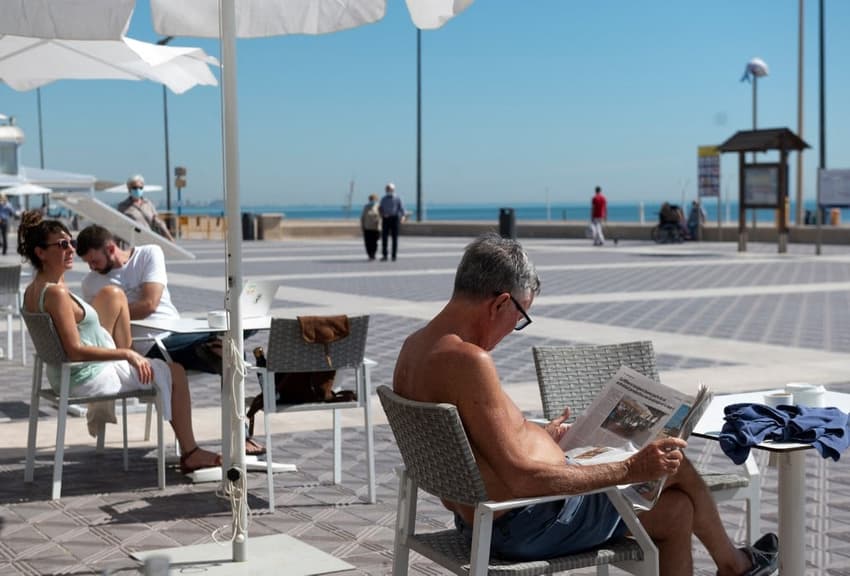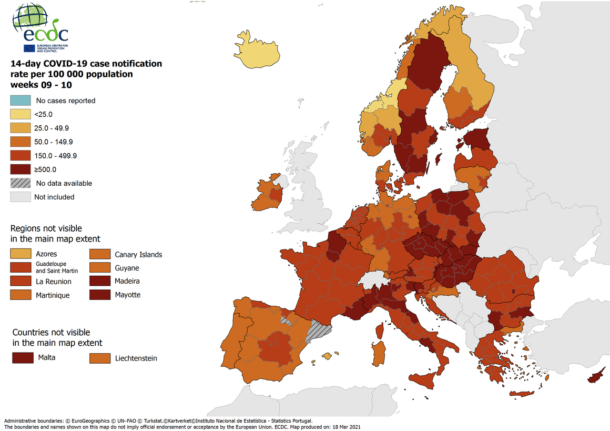How Spain's Valencia region achieved one of Europe's lowest infection rates

In the space of less than two months, the Mediterranean region went from having a 14-day infection rate of 1,500 cases per 100,000 inhabitants all the way down to 31 per 100,000 on March 23rd. What changed?
As things stand, La Comunidad Valenciana has the lowest infection rate of all of Spain’s 17 regions, with a drop of 53 percent in cases over the past fortnight, according to Spanish health ministry data.
Their 14-day cumilative infection rate of 31 cases per 100,000 inhabitants is six times lower than that of Madrid’s (216 per 100,000) and four times smaller than the national average of 128 per 100,000.
National newspaper ABC on Friday referred to the Valencian figures as “one of the lowest regional infection rates in the world”, an accolade which is certainly hard to verify, but if Spanish health ministry data is accurate, La Comunidad Valenciana’s infection rate could be on a par with some regions in Norway and Finland, which the latest ECDC map from March 18th showcases as the areas with the lowest reported infection rate in the EU/EEA (together with Iceland).

It’s true that infection rates can fluctuate quickly, but Valencia has been on a downward trend since February. Since the ECDC’s map above was published last Thursday, the region’s infection rate has gone from 39 cases per 100,000 inhabitants to 31 per 100,000.
In fact, Valencian regional president Ximo Puig stated over the weekend that 94 percent of municipalities - 508 out the 542 that make up the region - had an incidence rate below 25 cases per 100,000 inhabitants for the previous fortnight, the lowest risk category before the “no cases reported” blue labelling all nations are hoping to achieve in the near future.
Of the three provinces that make up the region, Alicante has the lowest 14-day infection rate with 25 cases per 100,000 inhabitants, followed by Castellón with 32/100,000 and Valencia with 34/100,000. The government’s Covid statistics page shows that the 7-day infection rate is lower still: 6,10 and 10 per 100,000 respectively.
How did the Valencia region achieve such a low infection rate?
The eastern region of five million inhabitants went from being the epicentre of Spain’s third wave of the coronavirus after Christmas to where it is now in large part because restrictions were kept in place for longer. As a result, the Valencian government passed a decree on January 19th which their regional head referred to as "the strictest rules in the country".
There was the total closure of the hospitality industry for 40 days, and bars, restaurants and cafés are still having to abide by restrictions on capacity limits outside and inside, as well as having to close at 6pm.
Crucially, Ximo Puig’s government prohibited all social gatherings throughout the region. The limit for meetings is now four people, outdoors and indoors.

Valencia's regional president Ximo Puig (centre) visits the City of Arts and Sciences with Spanish and German ministers. Photo: José Jordan/AFP
Added to this, the region’s sixteen main municipalities kept their borders closed until infection rates dropped, a measure which affected 2.3 million people.
Valencia’s Generalitat government also opted for the strictest curfew hours available - 10pm to 6am - which are still in place even though restrictions have been eased since the start of March.
The region also happens to have the lowest rate of PCR and antigen testing in Spain with 838 tests per 100,000 inhabitants; not because this matters less to citizens - the Generalitat has stated - but because there has been less need to get tested as residents have been sticking to the rules in place.
Overall, the Valencia government’s approach has been one of caution, taking longer to lift restrictions than other regions had as soon as infection rates improved, as well as keeping many measures in place until at least after Easter (regional borders will remain closed until May 9th).
This is of particular importance now that Germany’s government will allow its citizens to travel for their Easter holidays to the Valencia region and several other parts of Spain, in light of their improving epidemiological results.
Tourists from other parts of Europe can also visit the region (not Britons yet due to travel restrictions both in Spain and the UK), so the region’s next big challenge will be to keep that infection rate low when accepting visitors from countries with generally higher infection rates than Valencia, and Spain for that matter.
For residents of the sundrenched comunidad, who have withstood months of perimetral closures and still won’t be able to leave the region over Holy Week, it’s a case of hoping that all the hard work and positive results don’t get spoiled simply for the sake of tourism.
There's also the fear that the fourth wave could be initiated by new Covid strains such as the British one (which already account for a third of new infections in the region), as well as delays to the vaccine rollout.
Valencian health workers have so far administered more than half a million doses of the coronavirus vaccine but only 172,794 people have received both doses, out of a population of five million.
Comments
See Also
As things stand, La Comunidad Valenciana has the lowest infection rate of all of Spain’s 17 regions, with a drop of 53 percent in cases over the past fortnight, according to Spanish health ministry data.
Their 14-day cumilative infection rate of 31 cases per 100,000 inhabitants is six times lower than that of Madrid’s (216 per 100,000) and four times smaller than the national average of 128 per 100,000.
National newspaper ABC on Friday referred to the Valencian figures as “one of the lowest regional infection rates in the world”, an accolade which is certainly hard to verify, but if Spanish health ministry data is accurate, La Comunidad Valenciana’s infection rate could be on a par with some regions in Norway and Finland, which the latest ECDC map from March 18th showcases as the areas with the lowest reported infection rate in the EU/EEA (together with Iceland).

It’s true that infection rates can fluctuate quickly, but Valencia has been on a downward trend since February. Since the ECDC’s map above was published last Thursday, the region’s infection rate has gone from 39 cases per 100,000 inhabitants to 31 per 100,000.
In fact, Valencian regional president Ximo Puig stated over the weekend that 94 percent of municipalities - 508 out the 542 that make up the region - had an incidence rate below 25 cases per 100,000 inhabitants for the previous fortnight, the lowest risk category before the “no cases reported” blue labelling all nations are hoping to achieve in the near future.
Of the three provinces that make up the region, Alicante has the lowest 14-day infection rate with 25 cases per 100,000 inhabitants, followed by Castellón with 32/100,000 and Valencia with 34/100,000. The government’s Covid statistics page shows that the 7-day infection rate is lower still: 6,10 and 10 per 100,000 respectively.
How did the Valencia region achieve such a low infection rate?
The eastern region of five million inhabitants went from being the epicentre of Spain’s third wave of the coronavirus after Christmas to where it is now in large part because restrictions were kept in place for longer. As a result, the Valencian government passed a decree on January 19th which their regional head referred to as "the strictest rules in the country".
There was the total closure of the hospitality industry for 40 days, and bars, restaurants and cafés are still having to abide by restrictions on capacity limits outside and inside, as well as having to close at 6pm.
Crucially, Ximo Puig’s government prohibited all social gatherings throughout the region. The limit for meetings is now four people, outdoors and indoors.

Valencia's regional president Ximo Puig (centre) visits the City of Arts and Sciences with Spanish and German ministers. Photo: José Jordan/AFP
Added to this, the region’s sixteen main municipalities kept their borders closed until infection rates dropped, a measure which affected 2.3 million people.
Valencia’s Generalitat government also opted for the strictest curfew hours available - 10pm to 6am - which are still in place even though restrictions have been eased since the start of March.
The region also happens to have the lowest rate of PCR and antigen testing in Spain with 838 tests per 100,000 inhabitants; not because this matters less to citizens - the Generalitat has stated - but because there has been less need to get tested as residents have been sticking to the rules in place.
Overall, the Valencia government’s approach has been one of caution, taking longer to lift restrictions than other regions had as soon as infection rates improved, as well as keeping many measures in place until at least after Easter (regional borders will remain closed until May 9th).
This is of particular importance now that Germany’s government will allow its citizens to travel for their Easter holidays to the Valencia region and several other parts of Spain, in light of their improving epidemiological results.
Tourists from other parts of Europe can also visit the region (not Britons yet due to travel restrictions both in Spain and the UK), so the region’s next big challenge will be to keep that infection rate low when accepting visitors from countries with generally higher infection rates than Valencia, and Spain for that matter.
For residents of the sundrenched comunidad, who have withstood months of perimetral closures and still won’t be able to leave the region over Holy Week, it’s a case of hoping that all the hard work and positive results don’t get spoiled simply for the sake of tourism.
There's also the fear that the fourth wave could be initiated by new Covid strains such as the British one (which already account for a third of new infections in the region), as well as delays to the vaccine rollout.
Valencian health workers have so far administered more than half a million doses of the coronavirus vaccine but only 172,794 people have received both doses, out of a population of five million.
Join the conversation in our comments section below. Share your own views and experience and if you have a question or suggestion for our journalists then email us at [email protected].
Please keep comments civil, constructive and on topic – and make sure to read our terms of use before getting involved.
Please log in here to leave a comment.